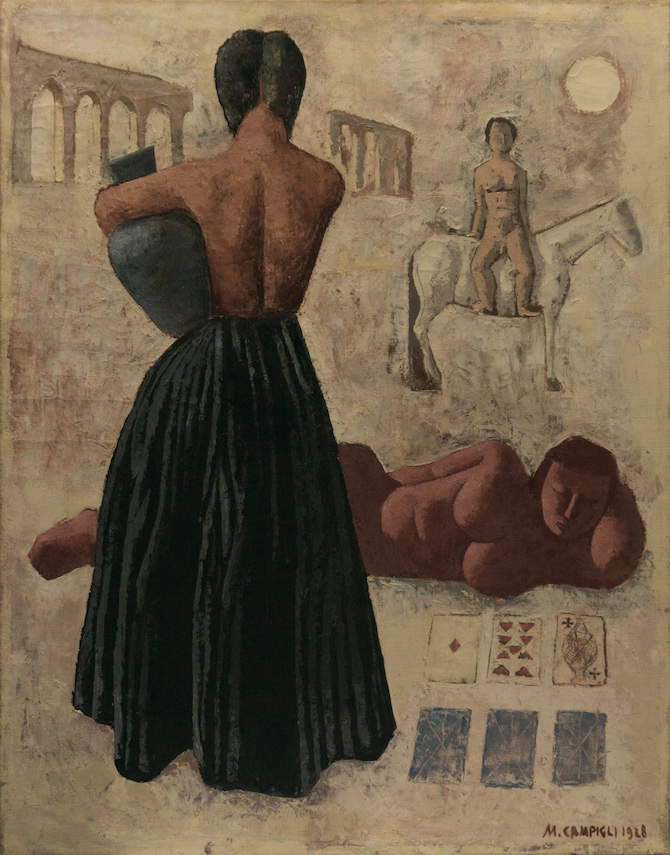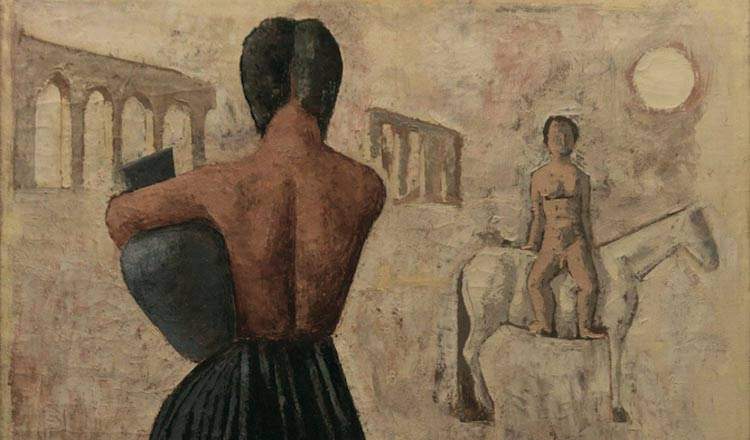From May 22 to September 30, 2021, ACP - Palazzo Franchetti in Venice is hosting the exhibition Massimo Campigli and the Etruscans. A Pagan Happiness, an exhibition dedicated to the relationship between Massimo Campigli (Berlin, 1895 Saint-Tropez, 1971) andEtruscan art. The exhibition takes as its starting point Campigli’s visit to the Etruscan Museum of Villa Giulia in Rome in 1928, later described by the artist in these words, “A pagan happiness entered into my paintings both in the spirit of the subjects and in the spirit of the work, which became freer and more lyrical.”
Campigli attributed to that visit a fundamental value for the development of the most mature phase of his artistic production. And it is precisely from these words that the exhibition at ACP - Palazzo Franchetti in Venice, curated by Franco Calarota with the general supervision of Alessia Calarota, takes shape.The exhibition is intended to be a dialogue between the master’s works and the examples of the past from which he drew such strong inspiration. The approximately thirty-five works by Campigli selected for the exhibition are flanked by about fifty artifacts from Etruscan civilization, many of them previously unpublished and exhibited here for the first time, identified by Superintendent Margherita Eichberg together with scholars from the scientific committee Leonardo Bochicchio, Simona Carosi, Daniele Federico Maras, and Rossella Zaccagnini, joined by research director Giovanni Cesarini. The exhibition also benefited from the scientific contribution of art historian Martina Corgnati. The catalog, published by Silvana Editoriale, is completed with texts by Enrico Mascelloni and Eva Weiss.
The exhibition aims to establish a profound dialogue between Campigli and Etruscan art. Campigli’s deliberately archaic compositions represented in the exhibition with paintings ranging from 1928 to 1966, find the origins of their inspiration in the Etruscan artifacts on display with which a natural sharing of atmosphere, signs and colors is established. As Franco Calarota points out, “Beginning with the famous visit to the Etruscan Museum of Villa Giulia in Rome in 1928, there is a sort of return to a primordial purity in Campigli’s art, to an ancient flavor made of soft colors as fresco paintings so similar to how time has given us back Etruscan images, of shapes shaped according to the design of votive statues or amphorae, of female figures with hourglass busts that abstract into timeless images.” Two works in the exhibition, Bust with Blue Vase and Gypsies, are precisely from 1928 and clearly mark the shift toward a new figuration, which becomes increasingly evident in works such as Women with Umbrellas from 1940 to the Sitting Woman of 1961.
 |
| Massimo Campigli, Gypsies (1928) |
The different types of the exhibits on display, from vases to statuettes, from jewelry to sarcophagi, aims to trace an alphabet and a universe of connections that, starting from general evocations, are declined into punctual references in the different sections of the exhibition: the first dedicated to the human figure, divided into men and women; the second to animals, composed of birds, horses, and wild animals; and finally the third with shapes and geometries. Many of the exhibits, as anticipated, are unpublished and come from major archaeological material recovery operations, including from renowned international museums, and now in the availability of the Soprintendenza Archeologia, Belle Arti e paesaggio for the province of Viterbo and Southern Etruria.
“The focus has been on the terracotta faces, from which the artist drew inspiration for the conception of a type of stereotypical portrait untethered from the direct reproduction of reality,” explains Margherita Eichberg, “the bronzes and ceramic vases decorated with human figures (male and female) and animals, subjects that appear (almost quotations) in the artist’s works; the bucchero and impasto vases with geometric and curved shapes that inspired the female silhouettes in some of his works; and finally the jewelry, a true passion of Campigli’s.” Also featured in the exhibition are two precious terracotta sarcophagi from the Civic Museum of Viterbo: a female clay sarcophagus from the second half of the 3rd century B.C. and a male clay sarcophagus from the late 3rd, early 2nd centuries B.C. Through the appeal of these expressive formulas belonging to a glorious past civilization, Campigli’s art reveals a profound originality precisely in the coexistence of ancient splendor and actuality, immersing the visitor in a dimension where time seems to stand still or flow quietly in an imperturbable stillness. It shows us a twentieth century contemporary with the most ancient ages of the Mediterranean, thus writing a very interesting page of what archaeologist Massimo Pallottino has defined as the “Etruscan novel,” a myth that from the Renaissance onward continues to exert a strong fascination from generation to generation. For all information about the exhibition you can visit the ACP - Palazzo Franchetti website.
 |
| Venice, an exhibition recounts the dialogue between Massimo Campigli and Etruscan art |
Warning: the translation into English of the original Italian article was created using automatic tools. We undertake to review all articles, but we do not guarantee the total absence of inaccuracies in the translation due to the program. You can find the original by clicking on the ITA button. If you find any mistake,please contact us.